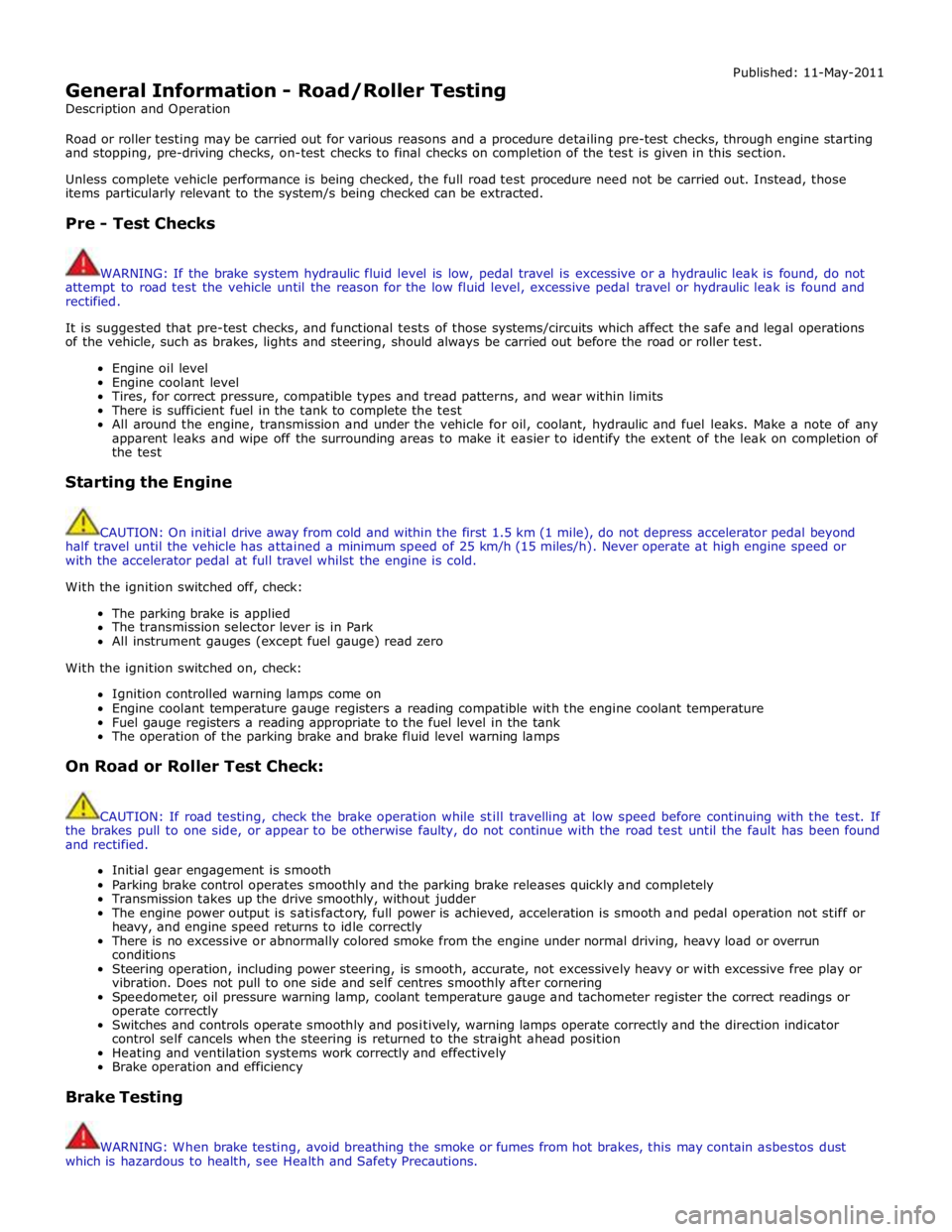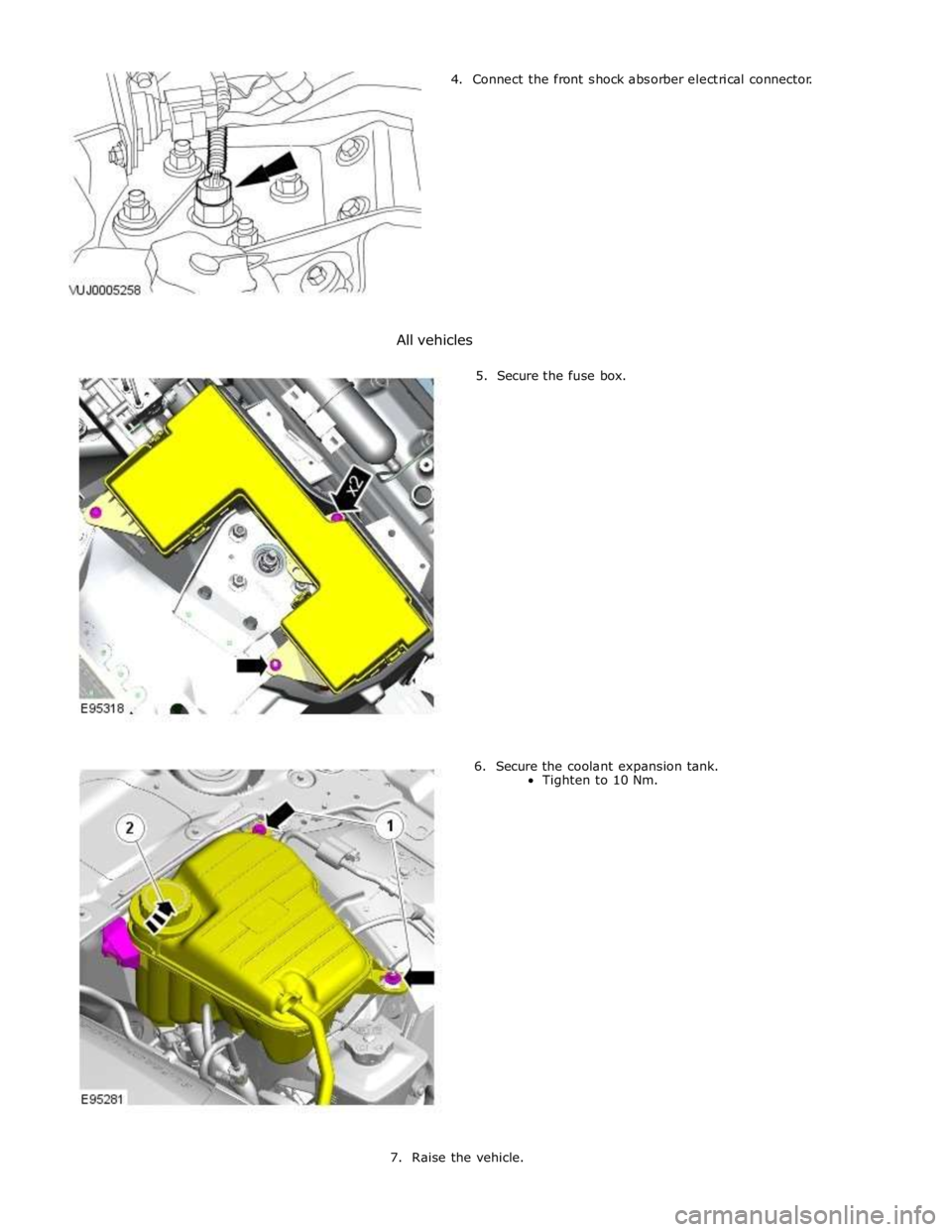Coolant JAGUAR XFR 2010 1.G Workshop Manual
[x] Cancel search | Manufacturer: JAGUAR, Model Year: 2010, Model line: XFR, Model: JAGUAR XFR 2010 1.GPages: 3039, PDF Size: 58.49 MB
Page 12 of 3039

SpecificationDescription and OperationComponent Location
Overview
System Operation and Component DescriptionDiagnosis and TestingEngine Cooling - V8 5.0L Petrol/V8 S/C 5.0L PetrolGeneral ProceduresCooling System Draining and Vacuum Filling
Cooling System Partial Draining, Filling and Bleeding - V8 S/C 5.0L Petrol
Cooling System Draining, Filling and Bleeding - V8 S/C 5.0L PetrolRemoval and InstallationAuxiliary Radiator
Coolant Expansion Tank
Cooling Fan Motor and Shroud - Vehicles With: Supercharger
Cooling Module - Vehicles With: Supercharger
Coolant Pump - Vehicles With: Supercharger
Radiator (26.40.01) - Vehicles With: Supercharger
Thermostat Housing - Vehicles With: Supercharger303-03D: Supercharger Cooling - V8 S/C 5.0L Petrol
Description and OperationComponent Location
Overview
System Operation and Component DescriptionRemoval and InstallationRadiator303-04E: Fuel Charging and Controls - V8 S/C 5.0L PetrolSpecificationDescription and OperationComponent Location
Overview
System Operation and Component DescriptionDiagnosis and TestingFuel Charging and ControlsGeneral ProceduresFuel Injection Component CleaningRemoval and InstallationFuel Injectors
Fuel Rail LH
Fuel Rail RH
Left-Hand Fuel Rail High-Pressure Fuel Pump
Right-Hand Fuel Rail High-Pressure Fuel Pump303-03C: Engine Cooling - V8 5.0L Petrol/V8 S/C 5.0L Petrol
Page 15 of 3039

Catalyst Monitor Sensor RH
Crankshaft Position (CKP) Sensor
Engine Control Module (ECM)
Engine Coolant Temperature (ECT) Sensor
Engine Oil Level Sensor
Front Knock Sensor (KS) LH
Front Knock Sensor (KS) RH
Fuel Rail Pressure (FRP) Sensor
Heated Oxygen Sensor (HO2S) LH
Heated Oxygen Sensor (HO2S) RH
Manifold Absolute Pressure (MAP) Sensor
Mass Air Flow (MAF) Sensor
Rear Knock Sensor (KS) LH
Rear Knock Sensor (KS) RH
Variable Valve Timing (VVT) Oil Control Solenoid LH
Variable Valve Timing (VVT) Oil Control Solenoid RH307: Automatic Transmission/Transaxle
307-01B: Automatic Transmission/Transaxle - TDV6 3.0L Diesel /V8 5.0L Petrol/V8 S/C 5.0L
PetrolSpecificationDescription and OperationComponent Location
Overview
System Operation and Component DescriptionDiagnosis and TestingDiagnosticsGeneral ProceduresTransmission Fluid Level Check
Transmission Fluid Drain and RefillRemoval and InstallationInput Shaft Seal
Extension Housing Seal
Transmission Control Module (TCM) and Main Control Valve Body
Transmission Fluid Pan, Gasket and Filter
Transmission Support Insulator - V8 5.0L Petrol/V8 S/C 5.0L Petrol
Transmission, Transmission Fluid Cooler and Transmission Fluid Cooler Tubes - V8 5.0L Petrol/V8
S/C 5.0L Petrol
Transmission and Transmission Fluid Cooler - V8 5.0L Petrol/V8 S/C 5.0L PetrolRemovalTransmission - V8 5.0L Petrol/V8 S/C 5.0L PetrolInstallationTransmission - V8 5.0L Petrol/V8 S/C 5.0L Petrol
Page 19 of 3039

Blower Motor Control Module
Center Registers
Climate Control Assembly
Climate Control Module
Defrost Vent/Register Blend Door Actuator
Driver Side Register
Evaporator
Floor Console Register
Footwell Vent/Duct Blend Door Actuator
Heater Core
Heater Core and Evaporator Core Housing
Instrument Panel Register Trim Panel
In-Vehicle Temperature Sensor
Passenger Side Register
Pollen Filter
Recirculation Blend Door Actuator
Sunload Sensor
Thermostatic Expansion Valve
Desiccant Bag - V6 3.0L Petrol/V8 5.0L Petrol/V8 S/C 5.0L Petrol412-02: Auxiliary Climate ControlSpecificationDescription and OperationComponent Location
System Operation and Component DescriptionRemoval and InstallationAuxiliary Coolant Flow Pump
Electric Booster Heater412-03: Air ConditioningSpecificationDiagnosis and TestingAir ConditioningRemoval and InstallationAir Conditioning (A/C) Compressor - V8 5.0L Petrol/V8 S/C 5.0L Petrol
Condenser Core - V8 S/C 5.0L Petrol
Pressure Cutoff Switch (82.10.32)413: Instrumentation and Warning Systems
413-01: Instrument ClusterSpecificationDescription and OperationComponent Location
Overview
System Operation and Component Description
Page 53 of 3039

Bus Topology of a
communication
network Coast Clutch Solenoid CCS Camshaft Position CMP Indicates camshaft position Carbon dioxide CO² Colorless gas with a density of approximately 1.5 times that of air Carbon monoxide CO Poisonous gas produced as the result of incomplete combustion Chlorofluorocarbon CFC Catalytic converter
In-line exhaust system device used to reduce the level of engine exhaust
emissions Celsius C
SI term for the Centigrade scale, with freezing point at zero and boiling point at 100 degrees Compact Disc CD Cylinder Head Temperature
Sensor CHT Sensor A sensor for measuring the temperature of the cylinder head Central Junction Box CJB Crankshaft Position CKP Indicates crankshaft position Clutch Pedal Position CPP Indicates clutch pedal position Controller Area Network CAN
A communication system which allows control modules to be linked together Constant Velocity CV Cubic centimeter cm³ Central Security Module CSM Electronic module to support security system functionality Data Link Connector DLC
Connector providing access and/or control of the vehicle information, operating conditions, and diagnostic information Driver Door Module DDM Electronic module to support driver door functionality Driver Seat Module DSM Electronic module to support driver seat functionality Daytime Running Lamps DRL Deutsche Institut fur Normung DIN German standards regulation body Diagnostic Trouble Code DTC
An alpha/numeric identifier for a fault condition identified by the On-Board Diagnostic (OBD) system Direct current dc
Current which flows in one direction only, though it may have appreciable pulsations in its magnitude Domestic Data Bus D2B Digital Versatile Disc DVD Electronic Automatic Temperature Control EATC
Exhaust Gas Recirculation EGR Exhaust Gas Recirculation Temperature Sensor EGRT Sensing EGR function based on temperature change Electronic Brake Force
Distribution EBD
Engine Control Module ECM Electronic module to support engine functionality Electronic Crash Sensor ECS Sensor to measure severity of impact Engine Coolant Temperature ECT Engine Oil Pressure EOP European On-Board Diagnostic EOBD Electronic Pressure Control EPC Electrically Erasable
Programmable Read-Only Memory EEPROM
Erasable Programmable
Read-Only Memory EPROM
Evaporative Emission EVAP
System designed to prevent fuel vapor from escaping into the atmosphere. Typically includes a charcoal filled canister to absorb fuel vapor Flash Electrically Erasable
Programmable Read-Only Memory FEEPROM
Front Electronic Module FEM Flash Erasable Programmable
Read-Only Memory FEPROM
Frequency Modulation FM Fuel Pump Driver Module FPDM Fuel Rail Pressure FRP Generic Electronic Module GEM Ground GND
Electrical conductor used as a common return for an electrical circuit or
circuits, and with a relative zero potential Global Positioning System GPS Global System for Mobile
Communication GSM
Gross Vehicle Weight GVW Heated Oxygen Sensor HO2S Electrically heated oxygen sensor which induces fuelling corrections
Page 103 of 3039

General Information - Road/Roller Testing
Description and Operation Published: 11-May-2011
Road or roller testing may be carried out for various reasons and a procedure detailing pre-test checks, through engine starting
and stopping, pre-driving checks, on-test checks to final checks on completion of the test is given in this section.
Unless complete vehicle performance is being checked, the full road test procedure need not be carried out. Instead, those
items particularly relevant to the system/s being checked can be extracted.
Pre - Test Checks
WARNING: If the brake system hydraulic fluid level is low, pedal travel is excessive or a hydraulic leak is found, do not
attempt to road test the vehicle until the reason for the low fluid level, excessive pedal travel or hydraulic leak is found and
rectified.
It is suggested that pre-test checks, and functional tests of those systems/circuits which affect the safe and legal operations
of the vehicle, such as brakes, lights and steering, should always be carried out before the road or roller test.
Engine oil level
Engine coolant level
Tires, for correct pressure, compatible types and tread patterns, and wear within limits
There is sufficient fuel in the tank to complete the test
All around the engine, transmission and under the vehicle for oil, coolant, hydraulic and fuel leaks. Make a note of any
apparent leaks and wipe off the surrounding areas to make it easier to identify the extent of the leak on completion of
the test
Starting the Engine
CAUTION: On initial drive away from cold and within the first 1.5 km (1 mile), do not depress accelerator pedal beyond
half travel until the vehicle has attained a minimum speed of 25 km/h (15 miles/h). Never operate at high engine speed or
with the accelerator pedal at full travel whilst the engine is cold.
With the ignition switched off, check:
The parking brake is applied
The transmission selector lever is in Park
All instrument gauges (except fuel gauge) read zero
With the ignition switched on, check:
Ignition controlled warning lamps come on
Engine coolant temperature gauge registers a reading compatible with the engine coolant temperature
Fuel gauge registers a reading appropriate to the fuel level in the tank
The operation of the parking brake and brake fluid level warning lamps
On Road or Roller Test Check:
CAUTION: If road testing, check the brake operation while still travelling at low speed before continuing with the test. If
the brakes pull to one side, or appear to be otherwise faulty, do not continue with the road test until the fault has been found
and rectified.
Initial gear engagement is smooth
Parking brake control operates smoothly and the parking brake releases quickly and completely
Transmission takes up the drive smoothly, without judder
The engine power output is satisfactory, full power is achieved, acceleration is smooth and pedal operation not stiff or
heavy, and engine speed returns to idle correctly
There is no excessive or abnormally colored smoke from the engine under normal driving, heavy load or overrun
conditions
Steering operation, including power steering, is smooth, accurate, not excessively heavy or with excessive free play or
vibration. Does not pull to one side and self centres smoothly after cornering
Speedometer, oil pressure warning lamp, coolant temperature gauge and tachometer register the correct readings or
operate correctly
Switches and controls operate smoothly and positively, warning lamps operate correctly and the direction indicator
control self cancels when the steering is returned to the straight ahead position
Heating and ventilation systems work correctly and effectively
Brake operation and efficiency
Brake Testing
WARNING: When brake testing, avoid breathing the smoke or fumes from hot brakes, this may contain asbestos dust
which is hazardous to health, see Health and Safety Precautions.
Page 104 of 3039

Avoid brake testing on busy roads where it can cause inconvenience or danger to other road users.
CAUTION: Brake testing which includes heavy brake applications should not be carried out with new brake pads/discs or
linings/drums until the components have bedded-in. New brake friction components will not reach full efficiency until the
bedding-in process is complete.
Test the brakes at several speeds within the normal operating range using both light and heavy pedal pressure. Note any
tendency to snatch, pull or drag, and any undue delay in application or release.
Allow the vehicle to coast and note any tendency to pull to one side, or evidence that the brakes are binding.
After stopping the vehicle (not immediately after a period of heavy braking), carefully check the brake temperature. A disc
which feels hot, or appreciably hotter than the others, indicates that the brake is binding.
After completion of the test, check for:
Oil, coolant, hydraulic, air and fuel leaks
Abnormal temperature of any moving components or assemblies, e.g. wheel hubs, transmission, axle etc., which might
indicate over tightness or lack of lubrication
Page 142 of 3039

DTC Description Possible Causes Action B1082-49
Right Temperature
Damper Motor -
Internal electronic
failure
Right hand blend
stepper motor internal
electronic failure
Suspect the right hand blend stepper motor. Check and
install a new stepper motor as required, refer to the new
module/component installation note at the top of the DTC
Index B1083-01
Recirculation
Damper Motor -
General electrical
failure
RECIRC servo motor
circuits - short to
ground, power, open
circuit
Carry out any pinpoint tests associated with this DTC using
the manufacturer approved diagnostic system. Refer to the
electrical circuit diagrams and check RECIRC servo motor
circuit for short to ground, power, open circuit B1085-00
Defroster Damper
Motor - No sub
type information
Defrost stepper motor
internal or external
fault
Carry out any pinpoint tests associated with this DTC using
the manufacturer approved diagnostic system B1085-49
Defroster Damper
Motor - Internal
electronic failure
Defrost stepper motor
internal electronic
failure
Suspect the defrost stepper motor. Check and install a new
stepper motor as required, refer to the new
module/component installation note at the top of the DTC
Index B1086-00
Air Distribution
Damper Motor -
No sub type
information
Panel/foot stepper
motor internal or
external fault
Carry out any pinpoint tests associated with this DTC using
the manufacturer approved diagnostic system B1086-49
Air Distribution
Damper Motor -
Internal electronic
failure
Panel/foot stepper
motor internal
electronic failure
Suspect the panel/foot stepper motor. Check and install a
new stepper motor as required, refer to the new
module/component installation note at the top of the DTC
Index B1087-88
LIN Bus "A" - Bus
off
LIN Bus power #1
circuit - open circuit
Carry out any pinpoint tests associated with this DTC using
the manufacturer approved diagnostic system. Refer to the
electrical circuit diagrams and check LIN Bus power #1
circuit for open circuit B1088-88
LIN Bus "B" - Bus
off
LIN Bus power #2
circuit - open circuit
Carry out any pinpoint tests associated with this DTC using
the manufacturer approved diagnostic system. Refer to the
electrical circuit diagrams and check LIN Bus power #2
circuit for open circuit B11ED-68
Electric Heater
Control Module -
Event information
Event information.
Electric heater - invalid
communication
message
Clear DTC. With engine coolant temperature low, set
climate temperature to high and re-test. If DTC remains in
isolation suspect the PTC heater, check and install a new
heater as required, refer to the new module/component
installation note at the top of the DTC Index. If additional
LIN related DTCs are logged refer to the Actions for these
DTCs B11ED-87
Electric Heater
Control Module -
Missing message
Electric heater -
missing communication
message
Carry out any pinpoint tests associated with this DTC using
the manufacturer approved diagnostic system B11ED-96
Electric Heater
Control Module -
Component
internal failure
Component internal
failure
Suspect the PTC heater, check and install a new heater as
required, refer to the new module/component installation
note at the top of the DTC Index B11ED-98
Electric Heater
Control Module -
Component or
system over
temperature
Component or system
over temperature
Clear DTC. With engine coolant temperature low, set
climate temperature to high and re-test. If DTC remains
suspect the PTC heater, check and install a new heater as
required, refer to the new module/component installation
note at the top of the DTC Index B11EE-01
A/C Compressor -
General electrical
failure
Air conditioning
compressor clutch
solenoid circuits - short
to ground, power, open
circuit
Carry out any pinpoint tests associated with this DTC using
the manufacturer approved diagnostic system. Refer to the
electrical circuit diagrams and check air conditioning
compressor clutch solenoid circuits for short to ground,
power, open circuit
Page 173 of 3039

DTC Description Possible Causes Action P007B-24
Charge Air Cooler
Temperature Sensor Circuit
Range/Performance (Bank 1)
- Signal stuck high
NOTE: Jaguar circuit reference
IC_COOLANT_PMP_CTRL &
BOOST_PRESS_SENSOR_TEMP_SIG. Land
Rover circuit reference O_S_CACWPR &
I_A_BTS
Connector is disconnected,
connector pin is backed out,
connector pin corrosion
Fuse failure
Temperature and manifold absolute
pressure sensor circuit, short
circuit to ground, short circuit to
power, open circuit, high resistance
Temperature and manifold absolute
pressure sensor failure
Air charge coolant pump and
control circuit, short circuit to
ground, short circuit to power, open
circuit, high resistance
Air charge coolant pump relay
failure
Air charge coolant pump failure
Inspect connectors for signs of water
ingress, and pins for damage and/or
corrosion
Refer to electrical circuit diagrams
and check for fuse failure, install
new fuse as required
Refer to electrical circuit diagrams
and check the temperature and
manifold absolute pressure sensor
circuit for short circuit to ground,
short circuit to power, open circuit,
high resistance
Check and install a new temperature
and manifold absolute pressure
sensor as required
Refer to electrical circuit diagrams
and check the air charge coolant
pump and control circuit for short
circuit to ground, short circuit to
power, open circuit, high resistance
Refer to electrical circuit diagrams
and check the air charge coolant
pump for open circuit, high
resistance
Refer to the relevant section of the
workshop manual and check the air
charge coolant pump for correct
operation. Check and install a new
air charge coolant pump as required
Clear DTC and retest P007B-29
Charge Air Cooler
Temperature Sensor Circuit
Range/Performance (Bank 1)
- Signal invalid
NOTE: Jaguar circuit reference
IC_COOLANT_PMP_CTRL &
BOOST_PRESS_SENSOR_TEMP_SIG. Land
Rover circuit reference O_S_CACWPR &
I_A_BTS
Connector is disconnected,
connector pin is backed out,
connector pin corrosion
Fuse failure
Temperature and manifold absolute
pressure sensor circuit, short
circuit to ground, short circuit to
power, open circuit, high resistance
Temperature and manifold absolute
pressure sensor failure
Air charge coolant pump and
control circuit, short circuit to
ground, short circuit to power, open
circuit, high resistance
Air charge coolant pump relay
failure
Air charge coolant pump failure
Inspect connectors for signs of water
ingress, and pins for damage and/or
corrosion
Refer to electrical circuit diagrams
and check for fuse failure, install
new fuse as required
Refer to electrical circuit diagrams
and check the temperature and
manifold absolute pressure sensor
circuit for short circuit to ground,
short circuit to power, open circuit,
high resistance
Check and install a new temperature
and manifold absolute pressure
sensor as required
Refer to electrical circuit diagrams
and check the air charge coolant
pump and control circuit for short
circuit to ground, short circuit to
power, open circuit, high resistance
Refer to electrical circuit diagrams
and check the air charge coolant
pump for open circuit, high
resistance
Refer to the relevant section of the
workshop manual and check the air
charge coolant pump for correct
operation. Check and install a new
air charge coolant pump as required
Clear DTC and retest P007C-00
Charge Air Cooler
Temperature Sensor Circuit
Low (Bank 1) - No sub type
information
NOTE: - Circuit TMAP_TEMP_SENSOR
-
Charge air cooler temperature
sensor (Bank 1) circuit short circuit
to ground, open circuit, high
resistance
Charge air cooler temperature
sensor (Bank 1) failure
Refer to the electrical circuit
diagrams and check charge air cooler
temperature sensor (Bank 1) circuit
for short circuit to ground, open
circuit, high resistance
Check and install a new charge air
cooler temperature sensor (Bank 1)
as required. Refer to the warranty
policy and procedures manual, or
determine if any prior approval
programme is in operation, prior to
the installation of a new
module/component
Page 340 of 3039

4. Connect the front shock absorber electrical connector.
All vehicles
5. Secure the fuse box.
6. Secure the coolant expansion tank.
Tighten to 10 Nm.
7. Raise the vehicle.
Page 682 of 3039

Brake booster retaining nuts - all vehicles 25 18 - Exhaust gas recirculation valve coolant pipe - vehicles with 3.0L Diesel 9 - 80 Brake vacuum pump nut - vehicles with 3.0L Diesel 23 17 - Brake vacuum pump threaded stud - vehicles with 3.0L Diesel 13 10 - Brake vacuum pump bolts - vehicles with 3.0L Diesel 23 17 - Brake vacuum pump bolts - vehicles with 5.0L 12 9 -